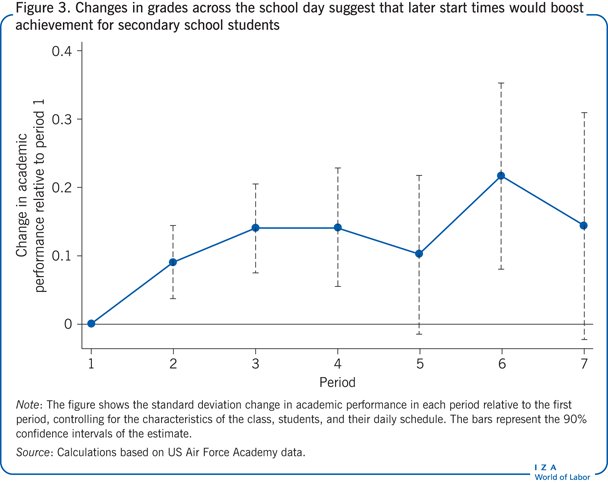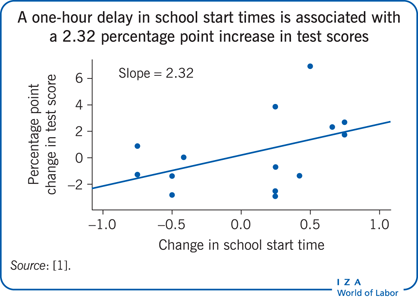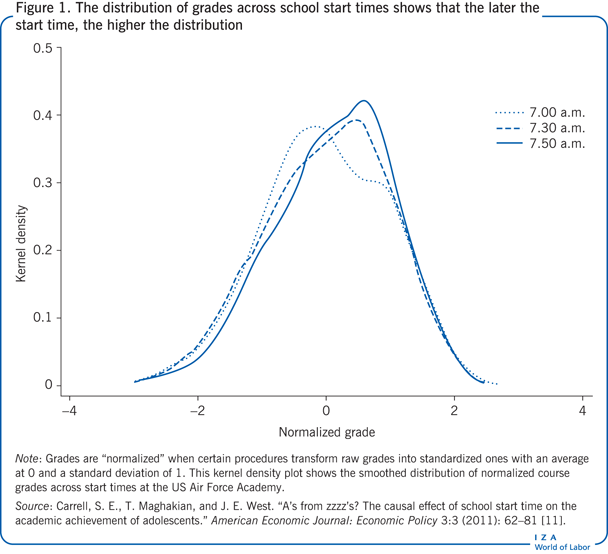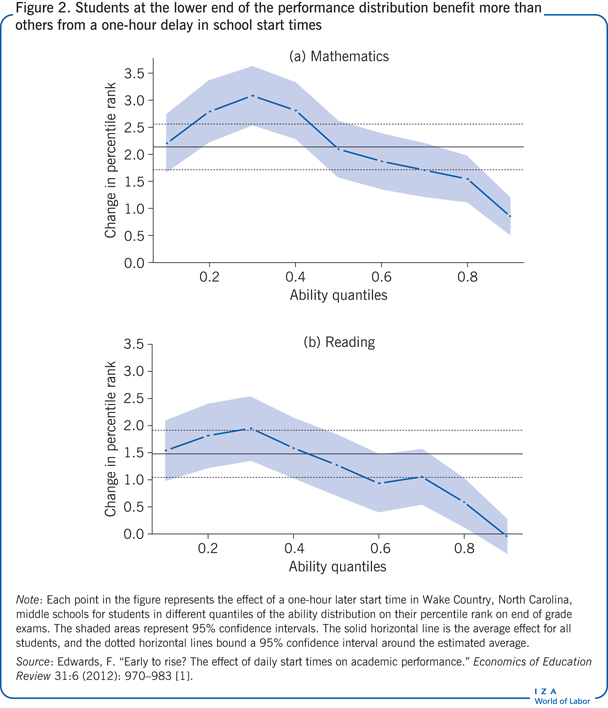Elevator pitch
The combination of changing sleep patterns in adolescence and early school start times leaves secondary school classrooms filled with sleep-deprived students. Evidence is growing that having adolescents start school later in the morning improves grades and emotional well-being, and even reduces car accidents. Opponents cite costly adjustments to bussing schedules and decreased time after school for jobs, sports, or other activities as reasons to retain the status quo. While changing school start times is not a costless policy, it is one of the easiest to implement and least expensive ways of improving academic achievement.
Key findings
Pros
Hours of sleep are positively correlated with academic achievement, yet traditional secondary school schedules lead to sleep deprivation among adolescent students.
Starting classes later in the morning improves grades in classes throughout the day and boosts standardized test scores.
Even small adjustments in start time can have beneficial effects.
Lower-ability students gain the most from delayed start times.
Delaying start times can be a very cost-effective measure for raising student achievement.
Cons
An optimal start time for secondary schools has not been determined.
Starting school later will require ending school later, reducing the amount of time available for homework, jobs, and extracurricular activities.
School districts that rely on one set of buses to serve all different levels of schools—e.g. elementary, middle, and high schools—may need to purchase additional buses or change the start time for the other school levels.
Reduced time for extracurricular activities may require scheduling adjustments or additional expenses.
Author's main message
Because adolescents have different internal clocks than younger children and adults, and later natural sleep and waking times, early secondary school start times are not conducive to learning. Empirical studies find sizable gains in test scores and grades from later start times for adolescents. A one-hour delay has the same effect as being in a class with a third fewer students or with a teacher whose performance is one standard deviation higher. Later start times are also shown to improve non-academic outcomes, such as mood and attendance, and reduce the frequency of automobile accidents. While changing start times is not costless, the benefits are likely to outweigh the costs.
Motivation
Sleep–wake cycles are governed by the circadian rhythm, a hard-wired “clock” in the brain that controls the production of the sleep-inducing hormone melatonin. In the early 1990s, researchers discovered that adolescents experience major changes in their circadian rhythm, with an approximately three-hour shift toward later bed and wake-up times, making 7.30 a.m. for an adolescent equivalent to 4.30 a.m. for an adult [2]. Ideally, students whose school starts early would go to bed early to ensure a full night’s sleep. However, because of this delay in circadian rhythm, adolescents are unable to fall asleep early enough to get eight or nine hours of sleep before they need to wake up for school, leading to an increase in daytime sleepiness. In much the same way, a typical adult would struggle to fall asleep at 8.00 p.m. in order to wake up at, say, 4.00 a.m. the next morning.
Thus, traditional school schedules affect adolescent sleep patterns by forcing adolescents to wake up and learn at a time when their bodies want to be asleep. A systematic review of adolescent sleep patterns across the world shows a linear trend toward later school-night bedtimes from age 11 to age 18 [3]. The majority of the students examined were deemed to be sleep-deprived after age 13.
Schools have spent a lot of money on improving student outcomes. They have hired better teachers, reduced class size, increased their use of technology, and changed class content and pedagogy, among other measures. Delaying school start times to better align with adolescents’ sleep–wake cycles offers sizable benefits to students’ academic and emotional outcomes at a relatively low cost.
Discussion of pros and cons
Adolescents all around the world start their school day early in the morning, at a time when their bodies prefer to be asleep. For example, in the US, most adolescents begin their school day around 7.30 a.m., several hours before their bodies are ready to wake up and begin the day’s activities. Studies from multiple disciplines and from many countries have indicated that early school start times lead to sleep deprivation among students and that hours of sleep are positively correlated with academic achievement [4]. While both correlational and anecdotal evidence point toward the benefits of later school start times, the causal relationship between start times and academic achievement has only recently been studied.
Empirical studies on sleep time and school start time
A few studies have looked at how time of day affects student performance. Scores on intelligence tests are significantly lower in the early morning hours for adolescents, which suggest that adolescents’ circadian rhythms affect their ability to learn and perform [5]. This hypothesis is supported by research that finds that college students perform better in classes that meet later in the day [6]. Similarly, in Chicago public high schools, both attendance and achievement are significantly lower in first-period classes than in other periods; this effect is particularly strong for mathematics classes [7]. While these studies begin to shed light on the relationship between time of day and learning, the estimated effects are likely biased due to students’ ability to select their classes. Students may choose to take a class with a friend or a class that is taught by an instructor they particularly like, or they may decide to schedule most of their classes during their preferred times of day for learning. Thus, these studies cannot tell us about the causal relationship between school start times and student academic achievement.
There are just a handful of empirical studies that have specifically assessed the academic effects of school start times. Despite the fact that these studies are based in the US, correlational research on start times and global sleep patterns give us no reason to believe that these findings are unique to US students. Most of these studies take advantage of natural experiments based on exogenous changes in school start times. Two studies use the start time change in Minneapolis public high schools from 7.15 a.m. to 8.40 a.m., which was introduced in the 1997/1998 school year. The first study examined course grades earned by students attending Minneapolis high schools in the three years before and the three years after the start time change and found a small, but statistically non-significant, improvement [8].
Grading often has a subjective component, and therefore grades are not easily comparable across instructors or time, the study admits the challenge that arises in measuring academic success with this metric. The second study examining the change in start times in Minneapolis looked at students’ ACT (American College Test) exam scores instead. The study compared the ACT scores of students in Minneapolis to those of students in St. Paul, Minneapolis’s “twin city,” where start times had not changed, and found that the later start times had no effect [9]. Although the ACT is scored more objectively than class assignments and tests, the exam correlates quite highly with general cognitive ability [10]. Since later school start times cannot change students’ innate ability, a delayed start time would not be expected to show any effect on ACT scores.
Another study aimed to answer this question by looking at end of the year standardized mathematics and reading test scores in middle schools in Wake County, North Carolina. School start times varied from 7.30 a.m. to 8.45 a.m. as a result of idiosyncrasies in school boundary changes and bus scheduling [1]. These differences enabled the study to explore the effect of later start times by comparing outcomes across schools with different start times and within schools that experienced a change in start time (some were assigned earlier start times while others were assigned later ones). The study finds that an increase in start times by one hour leads to a three percentile point gain in both mathematics and reading test scores for the average student.
A study analyzing course grade data for first-year students at the US Air Force Academy found similar results [11]. Several characteristics of the academic setting there allow for a compelling study of the effects of start time. First, the Air Force Academy had two changes in start times. Classes initially started at 7.30 a.m. They were then moved to 7.00 a.m. and later to 7.50 a.m. Second, students at the Air Force Academy are randomly assigned to their classes and professors during their first year, which eliminates the issue of students selecting into certain classes or class times. Additionally, all students take standardized exams for their core classes, and grading is standardized across all instructors teaching the same course in a given semester. Finally, attendance is mandatory for all classes.
Figure 1, which presents the distribution of students’ grades across the three different start times, shows that the later the start time, the higher the distribution of grades. The statistical analysis shows that a 50-minute delay in start times leads to a 0.15 standard deviation increase in course grades across the day. This effect comes not only from improved performance in a student’s earliest class, but also from improved performance in classes throughout the day. Despite the fact that students at the Air Force Academy are not average adolescents (they were high achievers in high school and self-selected into a military academy), there is no reason to believe that this group of students would be more adversely affected by early start times than the average adolescent.
Who benefits the most from start time changes?
Students across the entire ability distribution experience the benefits of later school start times, including the high-achieving students at the US Air Force Academy. Thus, delaying start times has the potential to make all students better off. However, certain students benefit more than others. Both the North Carolina and Air Force Academy studies find that the benefits of later start times are largest for students at the bottom of the grade distribution [1], [11]. Figure 2 shows how the effect of a one-hour delay in start times differs across the grade distribution at middle schools in Wake County, North Carolina. For instance, students in the 30th percentile of the ability distribution end up performing about three percentile points higher on the mathematics exam as a result of a one-hour delay in start time, while students at the 90th percentile perform around one percentile point higher. The fact that benefits differ across ability groups allows for opportunities to alter class schedules for some students if delaying the overall start time is not feasible. For example, for schools that have free periods as part of the daily schedule, the lower ability students could be given the first period off, allowing them to start their day later than their peers. Alternatively, their schedules could be set up so that they take their less rigorous classes early in the morning.
How large are the benefits?
The benefits of later school start times are quite large, especially when compared with other—more costly—educational interventions. A one-hour delay in a school’s start time has the same effect as being in a class with one-third fewer students or replacing an average teacher with one in the 84th percentile of effectiveness.
Delaying start times by one hour for students in secondary school would increase overall student achievement by roughly 0.10 standard deviation, on average. As in previous studies, this gain can be quantified as a dollar value in order to compare the benefits of this policy change with its potential costs [12]. A one standard deviation rise in test scores is estimated to increase future earnings by 8%. Assuming a 1% growth rate for real wages and productivity and a 4% discount rate, this translates to an approximately $10,000 increase in future earnings per student, on average, in present value terms. The benefit is even larger for students at the bottom of the grade distribution.
Channels of impact and optimal start times
There are at least two channels linking later school start times to improved academic outcomes. The first has to do with sleep and time of day. Early start times lead to increased sleep deprivation, which affects students throughout the day. Because adolescents do not become tired until around 11.00 p.m. or midnight, they are unable to fall asleep early enough to get the recommended amount of sleep. In addition, regardless of the duration of sleep, there are times of day when individuals are more alert and capable of learning. Later start times not only increase the duration of sleep, but they also align more of a student’s classes with the hours in the day when students are best able to learn.
A second channel through which later start times can boost academic outcomes is through improved attendance in the first classes of the day. At many schools, attendance is lower in early classes, and the later the start time, the higher the attendance in first-period classes [7]. However, class attendance is mandatory at the US Air Force Academy, which implies that the negative effects of early school start times are not driven solely by absences or tardiness.
While research has established that later start times can improve academic outcomes, no study has determined the optimal school start time. Studies show that between 7.00 a.m. and 8.45 a.m., later is better. However, whether students would benefit more from having school start even later, 9.30 a.m. for instance, has not been studied. The randomized scheduling at the US Air Force Academy provides the best opportunity to shed some light on this problem. The Air Force Academy study assessed how student performance differs across class periods relative to first period, holding all else constant [11]. As shown in Figure 3, the biggest gains would come from delaying start times to what is traditionally second or third period in many secondary schools (approximately 8.30–9.30 a.m.). In the US, most secondary schools start between 7.00 a.m. and 8.30 a.m., with a majority starting at 7.30 a.m. While there are clear gains to delaying start time to 8.00 a.m. or later, even small delays in the hour between 7.00 a.m. and 8.00 a.m. have been shown to increase achievement.

The costs of delaying school start times
Delaying start times, while far more cost-effective than many other education policies aimed at improving student achievement, is not costless. The two most costly changes, for instance in the US, that may be needed to accommodate delayed school start times would be a larger bus fleet and costs associated with moving after-school activities to later in the day: for example, outdoor lighting for athletic fields. While not insubstantial, the investment seems worthwhile given the large benefits for students of later start times. For schools without bussing systems and those able to accommodate extracurricular activities in other ways, the cost of this policy change can be even smaller.
To put the estimated costs discussed below in context, recall that delaying start times by one hour would result in an estimated 0.10 standard deviation increase in overall student achievement and an approximately $10,000 average increase in future earnings per student, in present value terms. In the US, the largest cost of delaying start times comes from altering bussing schedules for schools or districts that operate buses. Many districts stagger the start times of their three levels of schools—elementary, middle, and high—to use one set of buses for all schools. Generally, the high schools start first because of safety concerns arising from having younger children waiting outside for buses or walking to school very early in the morning, when it is still dark during much of the school year. Schools that currently provide bussing for their students and that want to change their high school start times will have to accommodate the change by having the other school levels start earlier (at no additional operating cost) or by operating more buses, at additional cost, so that all schools can start later in the morning. Having districts alter their bussing system so that all students start school at the same time would cost approximately $150 per student per year—or $1,950 over a student’s school career [10].
Another cost of later start times is the reduction in time available for after-school activities, such as athletic team practice. The average length of the US school day is 6.6 hours, so a 9.00 a.m. start time, for example, would coincide with a dismissal time of about 3.30 p.m. Many athletic coaches in US schools oppose later school start times because it would limit the number of daylight hours available for team practices and matches. This is less of a problem for indoor sports and other activities.
Schools have several options to offset this concern. One option is to install lights on athletic fields so that students can practice later in the day. The estimated cost of adding lights to athletic fields would be a one-time expense of approximately $110,000 and an annual operating cost of $2,500 [12]. The second option is to alter students’ schedules so that the last period of the day is made available for practice if they are on a sports team that practices outdoors. Finally, practices and extracurricular activities can be moved to the morning. While this would not allow students to get more sleep, it would better align class times with the times of day that students learn best.
Limitations and gaps
One limitation of the literature on later school start times is that it has been unable to distinguish how much of the benefits of later school start times arise from absolute learning (how much someone has learned) and how much from relative learning (how much someone has learned compared to their peers). For example, the measured effects of start time on course grades in the US Air Force Academy study are determined by the performance of students who have early start times relative to students taking the same course who start later and have a start time that is more conducive to learning and potentially allows them to get more sleep [11]. Because not all students at the Air Force Academy begin class at the same time, the study could not determine the effect of all students having an earlier or later start time. The effect the study measures is relative learning. Similarly, the North Carolina study looked at percentile scores on standardized tests as an outcome, which, by construction, are relative to peers’ test scores in the same year. In that setting, students’ percentile scores may increase as a result of later start times not only because of more sleep and increased learning in the classroom, but also because the test is taken at a time when students perform better.
Summary and policy advice
Secondary school students have been subject to school start times and schedules developed around the convenience of others, extracurricular activities, and the status quo, and not around their own best interests. Because adolescents have different internal clocks and sleep patterns than younger children and adults, early school start times are not conducive to their learning. Empirical studies of the impact of later start times on adolescents find sizable gains in grades and test scores. A one-hour delay in school start times leads to a 0.10 standard deviation increase in achievement (the same as improving from a grade of B to a B+ on an A to F scale) in classes throughout the entire day. Scholars across disciplines agree that adolescents would benefit from later school start times. A growing body of research outside of economics has found that delaying school start times has positive effects on a number of non-academic outcomes as well, including hours of sleep, attendance rates, mental health, and frequency of automobile accidents [13].
While research on sleep patterns across the world shows a linear trend toward later school-night bedtimes from age 11 to age 18 [3], sleep research also shows that the biological shift toward later time preference during adolescence usually shifts back in one’s early 20s. This pattern was also detected empirically in the study of Wake County middle schools, which finds that the benefits of later school start times increase with students’ age [1]. Thus, the policy discussion about later start times should focus first on high schools and then on middle schools, but does not apply to elementary schools.
These findings suggest that schools and districts have an opportunity to improve student learning and achievement by delaying middle and high school start times. Every school and district will face its own set of challenges associated with changing start times. Schools that do not provide bussing, have a dedicated set of buses for high school students, or already have lighted athletic fields will face the lowest associated costs. A pilot study can be a useful tool for schools and districts to assess the impact of the schedule change on their students. Districts with multiple high schools may choose to have one of the schools start later, while districts with one high school can institute a split schedule in which one set of students starts (and ends) the school day later.
For schools that are unable to delay start times, changing the configuration of the school schedule may also improve student outcomes. Research suggests that the benefits from later start times come not only from allowing students to get more sleep, but also from having classes that are better aligned with the time of day when students are best able to learn. Better alignment can also be achieved by scheduling extra-curricular activities, electives, and non-academic classes (such as physical education) at the start of the school day.
One of the biggest challenges to changing start times is measuring the impact of the change. Course grades at most schools are subjective, curved (assigned to yield a pre-determined distribution of grades), and not comparable across years or instructors. Standardized tests do not necessarily measure what students have learned, most obviously for subjects not tested and especially for students at the top of the grade distribution. Because of these issues, school districts need to be thorough in their assessment of the effects of later start times. Both quantitative measures of achievement (uncurved course grades, standardized test scores) and qualitative measures (feedback from students and teachers) should be assessed to get a complete picture of the impacts.
Acknowledgments
The author thanks an anonymous referee and the IZA World of Labor editors for many helpful suggestions on earlier drafts. The author also thanks Scott Carrell, Kevin Williams, and Jim West for their contribution to work on this topic. The views expressed in this article are those of the author and do not necessarily reflect the official policy or position of the US Air Force, the Department of Defense, or the US government.
Competing interests
The IZA World of Labor project is committed to the IZA Guiding Principles of Research Integrity. The author declares to have observed these principles.
© Teny Maghakian Shapiro


